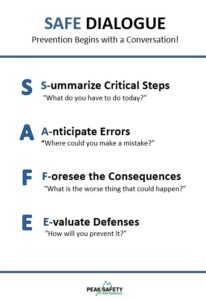Injury prevention begins with a SAFE DIALOGUE.
How to implement a SAFE DIALOGUE process with your leaders, click here.
SAFE DIALOGUE tutorial – click here.
Article in EHS Today Link.
SAFE DIALOGUE POSTER
What is a SAFE DIALOGUE?
 A SAFE DIALOGUE is a simple technique that leaders can use to engage the workforce and raise situational awareness. Individuals can benefit from the technique be thinking through their task. Teams can benefit by creating a questioning attitude.
A SAFE DIALOGUE is a simple technique that leaders can use to engage the workforce and raise situational awareness. Individuals can benefit from the technique be thinking through their task. Teams can benefit by creating a questioning attitude.
A SAFE DIALOGUE can help you avoid unsafe decisions. Have you ever had to investigate an accident that made you think, “What were they thinking? or They knew better than that?” We make choices every day that makes sense to us at the time BUT they have the potential to lead to accidents. Our ability to use good safe judgment can be the difference in a good or bad outcome.
How do you instill good safe judgment into the decisions that people make every day?
Prevention begins with a conversion! We have to learn to plan our steps, anticipate errors, think about the worst case consequence and evaluate our defenses. This simple SAFE DIALOGUE tool has to be a concrete habit in the way we do our work. If you ingrain the process into your task by task decisions, it will to influence the outcome in a positive way.
If you believe the worst case scenario can happen to you, doesn’t that impact your willingness to put safe practices in place?
Here are a few basic tips on the SAFE DIALOGUE thought process.
- Situational Awareness is the accuracy of a person’s knowledge of a task and working conditions compared to the actual conditions at a given time.
- In other words, you have to know what is going on around you and how it can impact what you are doing.
- Situation awareness requires the individual to clearly understand the job requirements, the equipment condition, and work environment before performing work.
- Injuries happen when there is a lack of situational awareness and failure in a safety system.
- Situational Awareness can impact the success of any process or system.
SAFE DIALOGUES will raise awareness and improve safety performance.
- Get your managers and supervisors involved in the SAFE DIALOGUE process.
- Your leadership has to support the mentality and enable employees.
- If there is uncertainty or confusion, the work is stopped, and the situation is addressed before workers continue with the task.
- The SAFE DIALOGUE is designed to help give people a tool to engage their workforce. It is an opportunity to help your co-workers.
- You maintain situational awareness through frequent questions, teamwork, and timely updates about current job conditions.
- The SAFE DIALOGUE is intended to provide a forum to get managers & co-workers involved in a highly visible way.
- The SAFE DIALOGUE promotes Management in Action and it encourages a Questioning Attitude:
- Questions raise awareness.
- Questions help you avoid blind spots.
- Questions reveal risk.
- Questions encourage you correct hazards.
- Questions show where things may go wrong.
Here is how SAFE DIALOGUE Works:
- Summarize the critical steps.
- Anticipate errors for each critical step and relevant error precursors.
- Foresee probable and worst-case consequences should an error occur during each critical step.
- Evaluate controls or contingencies at each critical step to prevent, catch, and recover from errors, and to reduce their consequences.
For a quick video tutorial on SAFE DIALOGUES, click here.